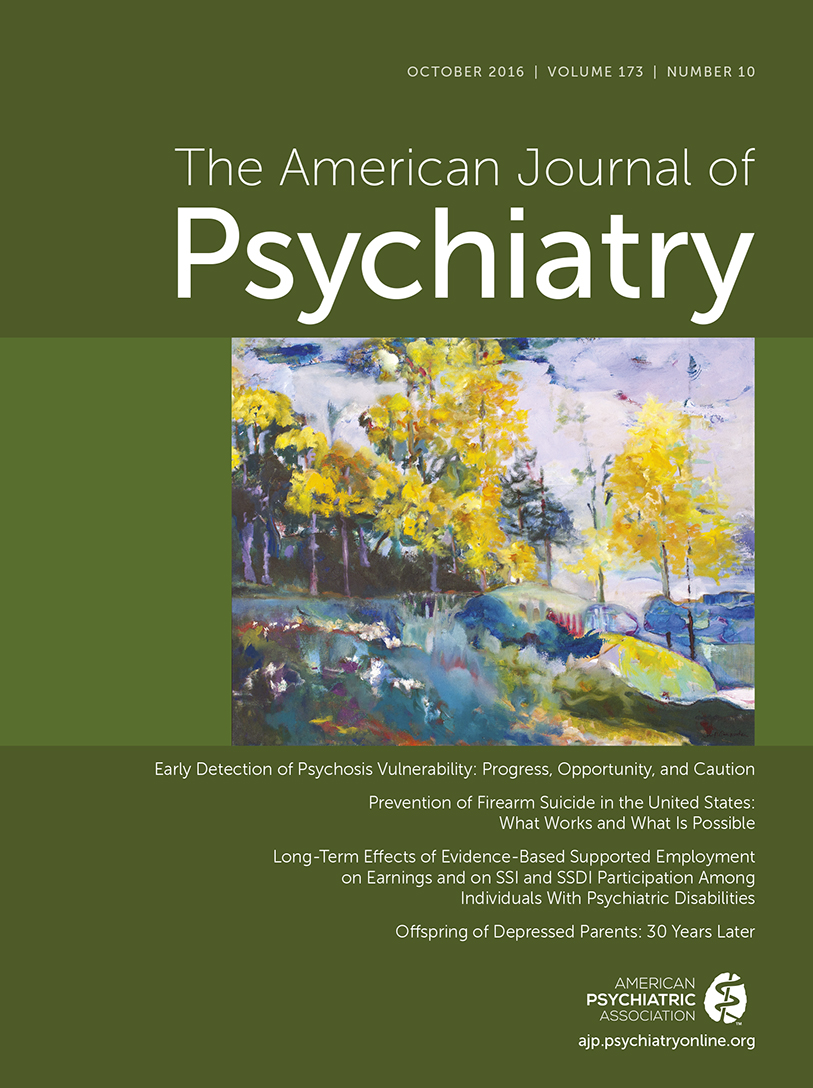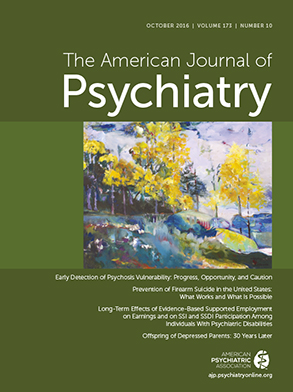Psychosis rarely emerges in young adults without ample warning earlier in development, in the form of transient psychotic-like symptoms, increased isolation, declining cognitive abilities, and a range of behavioral and performance issues leading to school and vocational problems. Throughout medicine, early detection and intervention before the onset of full-blown illness often improves outcomes. But identifying psychotic illness early is particularly challenging because the experiential and behavioral indicators of risk also occur in the general population, and most persons with early signs of psychosis risk do not progress to schizophrenia.
In developing DSM-5, the need for a clinical risk category was considered, with considerable debate. Of particular concern was the absence of reliability and validity data in nonexpert centers and the problem of a diagnosis implying psychosis risk where the majority of cases would not progress to a full psychotic disorder. Attenuated psychosis syndrome was placed in Section III of DSM-5 as a research diagnosis not yet ready for widespread clinical use. A diagnostic category for individuals at clinical high risk is needed to systematize research and facilitate translation to clinical practice. But a categorical diagnosis needs to be understood as a placeholder for a heterogeneous syndrome in which subsequent course information is essential for diagnostic clarification.
Our knowledge regarding early interventions is rapidly expanding (
1). Falloon first reported (
2) that early detection in primary care reduced progression to a diagnosis of schizophrenia. Yung et al. (
3) conceptualized clinical high risk in young people based on the schizophrenia prodrome and established a program in Australia that stimulated an international research effort and a national mental health program. A number of programs devoted to early detection research were funded by the U.S. National Institute of Mental Health at centers that collaborate and share data, forming the North American Prodrome Longitudinal Study consortium. One result of this collaboration is the risk calculator reported in this issue by Cannon and colleagues (
4). Determining key elements for risk prediction is important in clinical care, but it also addresses a critical challenge in intervention research. Clinical trials for secondary prevention of psychosis are hampered by our not knowing which individuals are actually on a path to full psychosis. The power in any clinical trial is reduced by the inclusion of participants who are not relevant to the treatment target. An immediate application for the risk calculator is in the selection of cases to enrich clinical trials with subjects who have a high probability of being informative regarding secondary prevention of full psychosis.
Cannon et al. (
4) report data from 596 clinical high-risk participants, of whom 84 progressed to a full psychosis. A prediction model for transition to psychosis using demographic, cognitive, symptomatic, and functional measures was developed, and a calculator assigns risk to individuals based on dimensional scoring of nine variables (the calculator can be viewed at
http://riskcalc.org:3838/napls/). The calculator’s intended use is restricted to investigators with data from structured interviews and expert cognitive assessment. Its immediate application will be in helping in the selection of participants for clinical trials or in psychopathology research, where the study cohort requires enrichment for psychosis vulnerability. That this goal may be accomplished with the risk calculator is reinforced by the article by Carrión and colleagues in this issue (
5), in which they report validation for the effectiveness of the risk calculator in an independent and substantial cohort.
The calculator is an appropriate tool because risk needs to be understood as the interactions between variables, all of which are entered simultaneously into the calculator. Cognitive and social problems are more problematic in the context of a known familial risk, such as a first-degree relative who is ill. Similarly, the risk conveyed by traumatic events is not great unless it is in the context of the other factors. The rating of symptoms that clinicians and families are likely to detect, such as unusual thought content and suspiciousness, only conveys greatly heightened risk in the context of other factors. Any of the risk factors, taken alone, is common in the healthy population.
While the risk calculator is not recommended for general clinical use, the information and concepts on which it is based can be incorporated in any clinical ascertainment of psychosis risk, although there are some concerns about such use. The calculation of a two-digit number may convey an unwarranted sense of precision for patients and their families. It is difficult for even the most sophisticated family to comprehend that probability does not convey inevitability. Even if a clinician is able to obtain the necessary cognitive testing and conduct the extensive interviews needed to use the calculator, the results do not indicate how the patient should be treated. Clinicians who assess these individuals must determine whether the person needs clinical care. The symptoms are usually fluid, insight is maintained, and associated anxiety, depression, sleep disturbance, substance abuse, social dysfunction, and impaired role functioning are appropriate issues for therapeutic intervention. The heightened concern for progression to full psychosis is important to consider with patients and families, but treatment is required for already present impairments and should not be delayed until full criteria for a psychotic disorder are met. Effective treatment for the present issues may be an aspect of secondary prevention of psychosis, but it is justified regardless of actual psychosis risk.
The risk calculator is a new tool that will refine acquisition of knowledge regarding therapeutics. There is already reason to expect substantial benefit from clinical interventions. Clinicians can reinforce family and community support, personal resilience, and compensatory mechanisms. Specific issues can be identified in each individual for clinical attention, including reducing stress and addressing nonpsychotic symptoms. Evidence-based treatment guidelines are emerging (
6), and research on clinical high risk is already documenting positive effects of treatment. Randomized controlled trials have documented reduced transition to psychosis rates at 6- to 48-month follow-up compared with treatment as usual (
7). Both experimental treatment, most often cognitive-behavioral therapy, and treatment as usual appear to enhance functional outcomes, regardless of transition to full psychosis. Early intervention also accomplishes a major goal for patients who transition to first psychosis. The average period of time that the first episode of psychosis remains untreated is estimated at 3 years in the United States (
8). Treatment appears to be more effective when the duration of untreated psychosis is brief, perhaps because the many adverse confounders associated with untreated psychosis, ranging from loss of social and occupational niche to behaviors destructive to self or others, are reduced. Continuity of care from clinical high risk to first episode should substantially reduce the duration of untreated psychosis.
Much more needs to be learned about early detection and intervention, but this appears to be the best near opportunity in psychiatry for advancing therapeutics. The risk calculator can enhance clinical trial methods and may contribute to a more personalized approach to preventing and ameliorating some of the most debilitating illnesses of early adulthood. As the field moves forward, early detection research is being extended to nonpsychotic mental disorders (
9), and assessment of risk will incorporate clinical and biological data subsequent to the initial assessment (
10).

